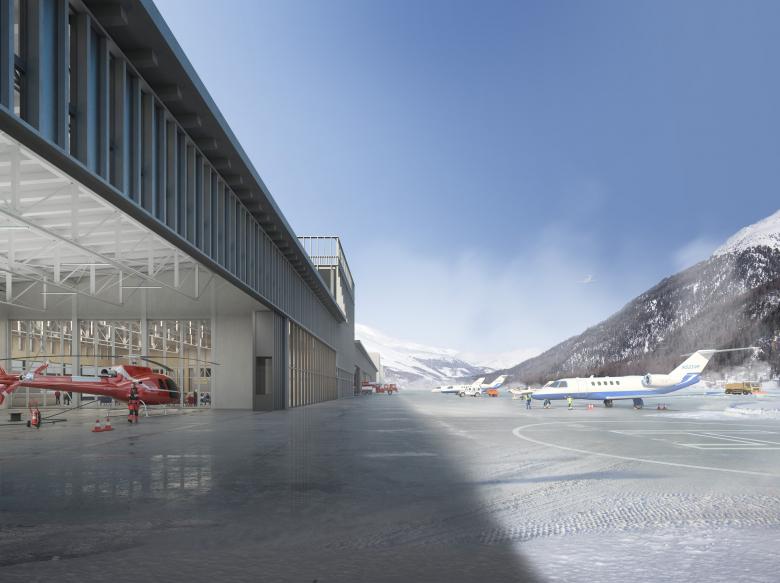Flughafen Engadin
Samedan, Switzerland
- Architects
- Hosoya Schaefer Architects
- Location
- Samedan, Switzerland
- Year
- 2025
- Client
- Infrastrukturunternehmung Regionalflughafen Samedan (INFRA RFS)
- Baumanagement (Bauleitung):
- Blarer & Reber Architekten AG, Samedan
- Fassadenplanung
- Dr. Lüchinger+Meyer Bauingenieure AG, Zürich
- Haustechnik (H/L/K/K)
- Balzer AG, Chur
- Haustechnik (S)
- Scherler AG, Chur
- Bauingenieur
- Dr. Lüchinger+Meyer Bauingenieure AG, Zürich
- Bauphysik / Akustik
- Kuster + Partner AG, Chur
- Gastroplaner
- promaFox AG, Bad Zurzach
- Erschliessungsschutz
- Balzer Ingenieure AG, Chur
- Sicherheitsplaner
- Hügli Ingenieurunternehmung AG, Bern
- Tiefbau
- F Preisig AG, Zürich/Chur
- Aviatik, Umwelt
- Bächtold+Moor AG, Bern
- Verkehrsplanung
- IBV Hüsler AG
REGIONAL AIRPORT SAMEDAN
Europe’s highest placed regional airport in the Upper Engadin (1,707 meters above sea level) will be modernized to meet the legal and regulatory requirements of a non-Schengen customs airport.
AN AIRPORT FOR THE VALLEY
The Engadin valley exists as a world of its own, consisting of a vast, magnificent landscape and the people who inhabit it or stay there for a visit. The new airport building will be accessible to the valley and its community, provide space and connect them to the world. It serves hobby pilots and VIPs, the alpine service of Rega and Heli Bernina as well as events and exhibitions. For non-aviation guests, the restaurant, terrace and terminal with panoramic views to the airfield are easily accessible. The project offers quick links between its various functions. Operations are concentrated in a small space, activities are combined and made visible. Employees and logistics are located around the passage between the operation buildings air- and landside, while visitors enter the area via the terminal.
GROSSFORM IN THE LANDSCAPE
The volume of the first phase sits as a linear, sculptural figure on the wide valley floor. The monolithic appearance of the building in the landscape contrasts with the transparency and accessibility of it when being close. The precisely articulated envelope made of dark metal panels with a continuous vertical grid connects the functional units into a large uniform volume. However, the repetitive façade is differentiated through various openings, windows, entrances and openings to the airfield. Both the human scale and the scale of the landscape can be found in the building.
A BUILDING WITH TRADITION AND TECHNOLOGY, DIVERSITY AND ABSTRACTION
The project is based on a clear master plan and a simple urban setting: functional units are arranged on a 30m wide band. The modular buildings with regular hangar sizes (20 m or 30 m deep) provide the greatest possible flexibility for planning and use. Four helicopter hangars in the South, parking and operations building airside in the North form two symmetrical wings. The operations building landside sits in the center as accent and landmark visible from afar. The hangars for wings and their additional program are defined in depth and appearance, but their exact height, length, function and phasing remains flexible. The landside operations building is the heart of the development.
Next to it is the terminal, which as a large, transparent hangar serves the valley as a gateway to the world. The terminal is not only the place for arrivals and departures but can serve also as foyer when hosting events and exhibitions. The building is organized vertically: on the ground floor the logistics with customs, handling and delivery; on the first floor all operational functions; in the second – the offices; in the third – restaurant, outdoor terrace and kitchen; in the fourth, the lounges and lodging, and finally the tower and roof terrace on the fifth floor. The slender structure – steel lattice trusses, which run in the longitudinal direction of the building, spans the open areas of the hangars and terminal. This is not only economically efficient but gives – tectonically and spatially – an aesthetic identity to the interior spaces.
Related Projects
Magazine
-
Digital Aids with Risks and Side Effects
2 days ago
-
Leave a Mark on Barcelona
3 days ago
-
Welcome to 2050
4 days ago
-
Fumihiko Maki, 1928–2024
4 days ago



